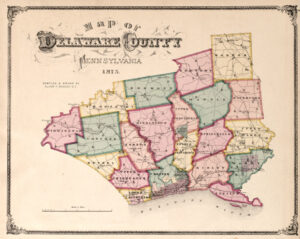Delaware County Atlas of Warrantees:
Earliest Landowners
Ancestor Tracks is committed to becoming a one-stop resource for researchers of early Pennsylvania landowners. In addition to publishing our own books, we are posting images of 19th century maps and atlases that we personally took in the Library of Congress. Our goal is to post landowner maps, or links to other websites with landowner maps, for every county in the state.
Original Land Owners
Although the state draftsmen working on the project to plat all of the earliest surveys on township maps never got around to mapping Delaware County, we are fortunate that Benjamin H. Smith took it upon himself to produce an atlas of the earliest patents in 1880. Many of these patents are dated before 1700. We are posting images of the copy of the atlas which is in the Library of Congress. See our explanation of how land was transferred from the government to individual owners from the earliest days of settlement.
Mr. Smith clearly used the Warrant Registers at the Pennsylvania State Archives to create the Warrantee Maps. He searched each county and parent county, then each alphabetical section chronologically, in the set of 67 county Warrant Registers plus 3 pre-1733 ledgers now available as digital downloads called First Landowners of PA: Colonial and State Warrant Registers in the PA Archives, Harrisburg, 1682-ca 1940 ($35) which can be downloaded and saved to your computer. (Free images are also posted on the Pennsylvania State Archives website where each page of each county’s ledger is a separate pdf file).
The Pennsylvania State Archives has posted the online survey books (both front and back side of each survey have been digitized) and you can order copies of the original documents from the Pennsylvania State Archives in Harrisburg using their order form.
It does not appear Mr. Smith searched Pennsylvania’s index to Patent Registers ($35). Within an index covering the relevant years, the names are grouped alphabetically by the first letter of the patentee’s surname, then grouped by volume number of Patent Book, and finally arranged chronologically by date of patent. Thus, the entire alphabetical section must be searched (which may be as little as one page to as many as 50).
Please note that these land transfers predate the deed books located in each county because they deal with the first transfer of land to private individuals from Pennsylvania’s colonial or state government. Once the land passed into the hands of a private owner, any subsequent transfer of the land was recorded as deeds in the county courthouse as it existed at that time.
19th-Century Residents
For researchers interested in later homeowners of Delaware County, there is an outstanding 1875 Combination Atlas Map showing residents of Delaware County published by Everts & Stewart at the Library of Congress. Use it in conjunction with Henry Ashmead’s 1884 History of Delaware County and George Smith’s 1862 History of Delaware County, Pennsylvania, from the Discovery of the Territory Included Within Its Limits to the Present Time.
Click on the township of your choice below. Once the images are loaded, they can be enlarged by clicking on them. If an image doesn’t enlarge, right-click on it and choose “Open Image in New Tab.” When it is opened in a new tab, you will be able to zoom in. You can also save the images.
While the map in the Library of Congress, is in the public domain the images we have taken belong to us and are not to be used for commercial use. For those wishing to use them for personal use (including illustrating a family history you are working on), we give permission to use them, but we would appreciate attribution to Ancestor Tracks. It takes much time and effort to locate, process, edit, and post these and the many other county images we have posted, so we appreciate this courtesy.
Index of Names
Townships
Aston Township
Bethel Township
Birmingham Township
Chester Township
Concord Township
Darby Township
Edgmont Township
Haverford Township
Marple Township
Middletown Township
Nether Providence & Springfield
Newtown Township
Radnor Township
Ridley Township
Thornbury Township
Tinicum Township
Upper & Lower Chichester
Upper Darby
Upper Providence


